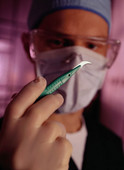
THURSDAY, April 4 (HealthDay News) — Injuries caused by sharp medical instruments are a major hazard for surgeons and other operating room staff, and put them at risk for infection with serious diseases, according to experts.
Nearly 400,000 “sharps” injuries occur each year in the United States, and about 25 percent of those injuries occur among surgeons, with their risk at the highest while in the operating room, said Dr. Kevin Chung and colleagues at the University of Michigan Health System.
Because fatigue and inexperience contribute to sharps injuries, residents and medical students are also at high risk, the study authors noted in their report, which is published in the April issue of the journal Plastic and Reconstructive Surgery.
“Despite health care policies designed to protect health care workers, [sharps] injuries remain common,” the investigators stated.
The biggest concern for those at risk is the fear of getting an infectious disease from a patient. While HIV, the virus that causes AIDS, is commonly considered the most feared outcome, the risk of infection with hepatitis B is actually much higher, according to Chung and colleagues.
In addition, sharps injuries can have a considerable psychological impact on the medical professional and their family members, especially while they wait to confirm that the injured person is free of infection, a process that can take weeks or months.
After a sharps injury, there are standard guidelines to follow if a patient has an infectious disease, according to a journal news release. This includes antiviral medications for health workers exposed to HIV and hepatitis B or C virus, ideally starting within hours after the injury.
The average cost for testing, follow-up and preventive treatment after a sharps injury ranges from $375 for needlestick exposure from a patient with no known blood-borne infectious disease up to nearly $2,500 for injuries from a patient with HIV.
Chung and colleagues said they hoped their review would help increase awareness of the risks and potential harms of sharps injuries among those working in an operating room, and would increase efforts to reduce the risk.
More information
The U.S. National Library of Medicine outlines how to handle needles and other sharps.

